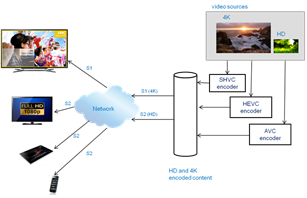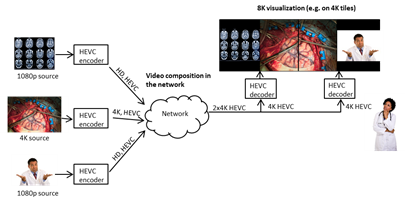Multimedia Delivery
The emergence of increasingly multimedia-rich Web applications puts strains on the available network resources. Increased demand for flawless quality of experience (QoE) for end users poses additional stringent requirements on the delivery system in terms of bandwidth, latency, synchronization and interactivity.
Therefore, current delivery architectures, such as content distribution networks (CDN) and peer-to-peer networks (P2P), have to be enhanced with novel intelligent mechanisms for:
- optimized storage of content (through caching, pre-fetching or pushing);
- short-term scheduling and buffering of content;
- pre-processing of resources at intermediate accelerator nodes;
- profile building of network, content and user resources in order to better predict traffic patterns and usage demand;
- orchestrated multimedia delivery through scalable usage of appropriate network resources to meet application-specific requirements;
In order to deploy these mechanisms in very heterogeneous environments (wired and wireless, single and multiple operators) on-the-fly and in a programmable way, software-defined networking (SDN) and network function virtualization (NFV) principles are brought into play.
Staff
Filip De Turck, Tim Wauters.
Researchers
Niels Bouten, Maxim Claeys, Stefano Petrangeli, Jeroen van der Hooft, Dries Pauwels.
Projects
- ICON V-FORCE: Video - 4K Composition and efficient streaming
- ICON PRO-FLOW : Predictive deliveRy Orchestration For ultra-LOw-latency Web applications
- ICON Shift-TV : Multi-screen Place and Time Shifted Television
Key publications
- Jeroen van der Hooft, Stefano Petrangeli, Tim Wauters, Rafael Huysegems, Patrice Alface, Tom Bostoen and Filip De Turck, “HTTP/2-Based Adaptive Streaming of HEVC Video over 4G/LTE Networks”, IEEE Communications Letters (IEEE CL), 2016.
- Stefano Petrangeli, Tim Wauters, Rafael Huysegems, Tom Bostoen and Filip De Turck. “Software-Defined Network-based Prioritization to Avoid Video Freezes in HTTP Adaptive Streaming”, International Journal of Network Management (IJNM), July 2016.
- Maxim Claeys, Niels Bouten, Danny De Vleeschauwer, Werner Van Leekwijck, Steven Latré, Filip De Turck. “Cooperative Announcement-based Caching for Video-on-Demand Streaming”, IEEE Transactions on Network and Service Management (TNSM), 2016.
- Stefano Petrangeli, Jeroen Famaey, Maxim Claeys, Steven Latré and Filip De Turck. “QoE-Driven Rate Adaptation Heuristic for Fair Adaptive Video Streaming”, ACM Transactions on Multimedia Computing, Communications and Applications (ACM TOMM), 2016.
- Niels Bouten, Ricardo de O. Schmidt, Jeroen Famaey, Steven Latré, Aiko Pras, Filip De Turck. “QoE-Driven In-Network Optimization for Adaptive Video Streaming Based on Packet Sampling Measurements”, Elsevier Computer Networks (COMNET), 2015.

